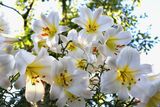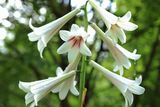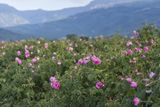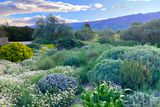Gardening: Something for the pot as wet winter rolls in
Gerry Daly
Fatsia - a shady character
Fatsia is looking good these days, despite the wet weather and the change of season. This plant flowers in autumn and into winter, unlike so many other plants that are busily battening down the hatches against what winter may throw at them. A glance at the flowers will reveal the family likeness to ivy, it being part of the ivy, or aralia, family.
The flower heads are composed of a branched head of rounded clusters of individual flowers, each of these single flowers are rounded and open to reveal pollen-carrying stamens and female parts. Later, when pollinated, the flowers become a cluster of black berries, just as ivy does. These seeds are usually viable and new plants can be raised. Like ivy, fatsia provides late nectar for bees and other flying insects but only on a sunny day when the insects can venture forth.
Fatsia is a shrub with woody stems and can reach to well over two metres. The stems are not very hard and, as the stems get longer, they tend to flop outwards a little, making a broad bush.
Native to Japan, it is evergreen with large leaves often more than 30cm long and almost as wide, divided into long finger-like segments. Although it is not completely hardy, it survives well in gardens, except perhaps in the coldest parts of the country. Even when damaged by frost, usually as a young plant, it sprouts back from buds lower on the damaged stems.
Apart from late-autumn flowering and good, glossy evergreen foliage, fatsia has other useful qualities. Very unusually for a large-leaved plant, it tolerates coastal exposure very well, being a coastal woodland plant in Japan. It might get some chafing in a very exposed location. It is very tolerant of grime and air pollution in towns and it can tolerate a significant degree of shade, its dark-green leaves coping well. So it is an excellent plant for dank city basements and back yards, bringing a touch of year-round greenery.
Fatsia is also good in a pot. It makes a good pot plant for areas with no access to soil and it is a fine conservatory plant for greenery in winter, enjoying the warmth of a conservatory. Grown in a pot, it needs to be watered and fed through the growing season. If it gets too big, it can be pruned as hard as wanted in early April and it will sprout new shoots and foliage.
There are variegated forms - 'Variegata' with cream edges and white 'Marginata'. 'Spider's Web', which is shown, has white speckled leaves.
Join the Irish Independent WhatsApp channel
Stay up to date with all the latest news














